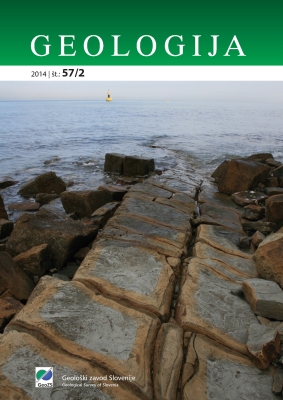Peloid iz zaliva Makirina (Severna Dalmacija, Republika Hrvaška) - njegova potencialna uporaba v balneoterapiji
DOI:
https://doi.org/10.5474/geologija.2014.014Povzetek
Recentne morske sedimente iz zaliva Makirina lahko glede na njihove organoleptične lastnosti obravnavamo kot zdravilno blato ali peloid, ki ga nekateri domačini in turisti že uporabljajo v obliki blatnih oblog. Uporaba peloidov v balneoterapiji je namenjena predvsem zdravljenju mišičnih, kostnih in kožnih obolenj ter sproščanju in velnesu. Številne nedavne raziskave peloidov so pokazale, da so eni izmed glavnih dejavnikov, ki pogojujejo (ne)uporabo peloida v balneoterapevtske namene, zrnavost, mineraloška sestava, kationska izmenjevalna kapaciteta (KIK), elementna in mikrobiološka sestava izvornega »geološkega materiala«. Iz rezultatov predhodnih raziskav je razvidno, da peloid iz zaliva Makirina gradi zelo slabo sortiran peščen mulj z visoko kationsko izmenjevalno kapaciteto (63,82 meq/100g). V mineralni sestavi peloida prevladujeta dolomit in kremen, sledijo ilit/muskovit, aragonit, kalcit, halit in pirit. Povprečne koncentracije potencialno toksičnih elementov (PTE) v peloidu iz zaliva Makirina, določenih v tokratni raziskavi znašajo: As (17,6 mg/kg), Cr (92,09 mg/kg), Cu (44,5 mg/kg), Mo (31,8 mg/kg), Pb (28,9 mg/kg) in Zn (69,2 mg/kg) in so primerljive z rezultati preteklih študij. Koncentracije PTE v bentoški algi Codium bursi (C. bursa) so sledeče: As (8,8 mg/kg), Cr (15,7 mg/kg), Cu (5,6 mg/kg), Mo (0,7 mg/kg), Pb (3,6 mg/kg) in Zn (16,3 mg/kg). Izračunani faktorji prenosa (TF) za PTE iz površinskega peloida (0-5 cm) v bentoško algo C. burso so manjši od 1, kar pomeni, da se PTE iz peloida ne prenašajo oziroma se v C. bursi ne akumulirajo. Rezultati prisotnosti koliformnih bakterij in E. coli se ujemajo s preteklimi rezultati, ki so pokazali, da jih v peloidu ni, kar nakazuje, da peloid ni fekalno kontaminiran. Peloid iz zaliva Makirina ima (z izjemo povišanih koncentracij Cr in Mo) primerljive lastnosti s peloidi, ki se trenutno že uspešno uporabljajo v različnih spa-centrih po svetu, vendar je treba pred potencialno uporabo opraviti dodatne raziskave, kot je na primer določitev mobilnosti Cr in Mo.Prenosi
Kako citirati
Komar, D., Dolenec, T., Vrhovnik, P., Rogan Šmuc, N., Lojen, S., Kniewald, G., Matešič, S. S., Lambaša Belak, Živana, & Dolenec, M. (2014). Peloid iz zaliva Makirina (Severna Dalmacija, Republika Hrvaška) - njegova potencialna uporaba v balneoterapiji. Geologija, 57(2), 167–176. https://doi.org/10.5474/geologija.2014.014
Številka
Rubrika
Članki

